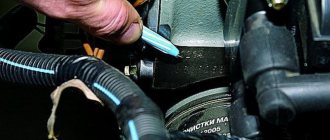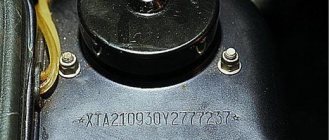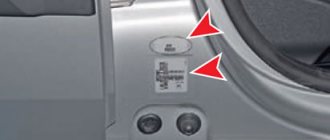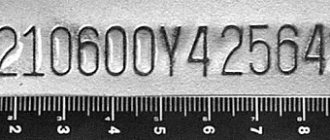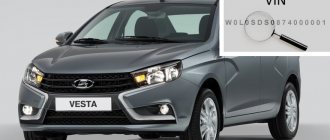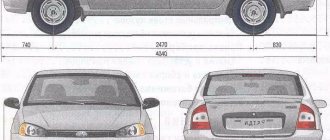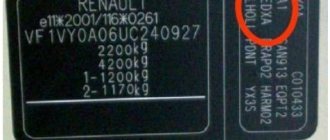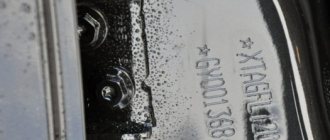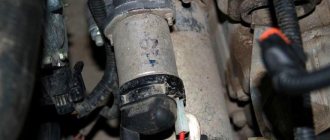Each vehicle is assigned a unique identification number (VIN). It is always seventeen digits long and consists of alphabetic and digital characters. Using this unique code you can find out a lot of useful information about the car: production date, place of assembly, brand, manufacturer. And this is not all the information. For example, by using the VIN code, you can find out whether the car was involved in an accident, whether it caught fire or was not flooded. The ability to correctly decipher the identification number will give you a great advantage when purchasing a car second-hand. You can prevent yourself from buying a dubious car.
There is no single international standard that defines how the VIN is constructed. Each manufacturer sets the rules for its formation himself. The system is built on such a principle that in no case should the number be repeated - the combination of characters must be unique over the past 30 years. Each car is assigned only one VIN, and it is the only one and cannot be found on another car. Typically, the VIN code is assigned to a vehicle by the final manufacturer, the one who directly puts the car into operation. The VIN number must be checked for each vehicle .
The entire VIN number is divided into sections. Acceptable characters that can be used in the number are a combination of Arabic numerals from 0 to 9 and letters of the Latin alphabet. The exceptions are the letters I, O, Q. They are not used to exclude the possibility of counterfeiting the number, because such letters can easily be replaced with others. It is possible to use separator characters to highlight individual subgroups of a number, to indicate the beginning of the code or its end.
Preface
1 DEVELOPED by the All-Russian Research Institute of Standardization and Certification in Mechanical Engineering (VNIINMASH)
INTRODUCED by the Technical Committee for Standardization TC 56 “Road Transport”
2 ADOPTED AND ENTERED INTO EFFECT by Resolution of the State Standard of Russia dated December 15, 2002 No. 469-st
3 Sections (subsections, appendices) of this standard, with the exception of section 1, paragraphs 2.1 and 3.2.8, subsection 3.3 and Appendix B, are identical to the text of international standards ISO 3779-83 “Road transport. Vehicle identification number. Content and structure", ISO 3780-83 "Road transport. International Manufacturers Identification Code”, ISO 4030-83 “Road vehicles. Vehicle identification number. Location and installation"
4 INTRODUCED FOR THE FIRST TIME
GOST R 51980-2002
STATE STANDARD OF THE RUSSIAN FEDERATION
Vehicles
General technical requirements
Vehicles. Marking. General technical requirements
Date of introduction 2004-01-01
This standard establishes general technical requirements for the content of the identification number (code) and the vehicle manufacturer's plate (hereinafter referred to as the vehicle), as well as for their location on the vehicle and the method of applying code signs.
In this standard, the following terms with corresponding definitions apply:
2.1 vehicles (vehicles):
Motor vehicles and wheeled self-propelled equipment of other types.
2.2 vehicle identification number (code)
— Vehicle Identification Number, VIN (hereinafter referred to as the VIN code): A structural combination of characters assigned to a vehicle for the purpose of its identification.
2.3 international manufacturer identification code
— World Manufacturer Identifier, WMI (hereinafter referred to as the WMI code): The first section of the VIN code, indicating the vehicle manufacturer. The WMI code is assigned to the vehicle manufacturer for the purpose of identifying this manufacturer. The WMI code, when used in conjunction with other sections of the VIN code, ensures the uniqueness of the latter for all vehicles produced within 30 years in all countries of the world.
2.4 descriptive part of the VIN code
— Vehicle Descriptor Section, VDS: The second section of the VIN code. Contains information describing the main features of the vehicle. This section of the VIN code can indicate the vehicle type, type variants and versions.
2.5 index part of the VIN code
— Vehicle Indicator Section, VIS: The third section of the VIN code. Consists of a combination of signs assigned by the manufacturer in order to distinguish one vehicle from another. This section of the VIN code, together with the VDS, provides unique identification of all vehicles produced by each manufacturer over a 30-year period.
2.6 manufacturer:
The person or organization responsible for the vehicle, assembled until it is ready for use. The manufacturer is also responsible for the uniqueness of the VIN code.
2.7 delimiter:
A symbol, sign, or other boundary designation that can be used to delimit sections of a VIN code or indicate the beginning and end of a VIN code. Separators must be such that they cannot be mistaken for Arabic numerals or Latin letters.
2.8 year of issue:
Calendar year in which the vehicle was produced.
2.9 model year:
The conditional year indicated by the manufacturer (usually following the actual year of manufacture of the vehicle).
WMI
WMI - International Manufacturer Identification Code. Consists of three characters (letters or numbers).
The first character indicates a geographic area, the second indicates a country within that area, and the third indicates a specific manufacturer (sometimes a vehicle type).
If the manufacturer produces less than 500 DTS per year, then the third character of the code is the number 9.
Several WMIs may be assigned to a manufacturer, but the same number may not be assigned to another vehicle manufacturer for at least 30 years from the moment it was first used by the previous (first) manufacturer.
So, the first character of WMI is a letter or number representing the geographic area code. Each zone is assigned several symbols:
- from A to H - Africa;
- from J to R - Asia;
- from S to Z - Europe;
- from 1 to 5 - North America;
- from 6 to 7 - Oceania;
- from 8 to 9 - South America;
The second character (country code) is a letter or number that represents the country. To ensure flexibility and unambiguity in identification, a specific country is determined by a combination of the first and second digits of the code:
Despite the parameters clearly stated in the standard, the designation assigned to the country of origin is not always used. For example, cars of the European branch of General Motors, whose head office is in Germany, are labeled as W0, regardless of the country of origin (be it Germany, Spain, Great Britain, Belgium or Poland).
The third character is a letter or number that is assigned to the manufacturer by the national organization. Can also mean vehicle type or production department.
VDS
The second part of the VIN code is the description - a descriptor of the car.
The 4th, 5th, 6th, 7th, 8th characters are used to determine the type of vehicle and describe the characteristics of the vehicle:
- model line,
- body type,
- engine's type,
- steering wheel position,
- power system and transmission type,
- drive unit,
- etc.
Each manufacturer has its own set of parameters, its own sequence and its own unique designations.
The 8th character is used in most cases to determine the engine type. Unused positions are filled with signs at the discretion of the manufacturer.
The 9th character - for manufacturers in the USA and China (as well as those who export cars to the USA) - is a check digit, which is one of the means of protection against number alterations. European, Japanese and Korean companies do not always follow the standard, and use this symbol for additional information about the car.
Lada granta - which engine is better?
Today I will talk about the engines that are installed on the Lada Granta. Today, only four engines are installed on this car. I will try to briefly talk about the characteristics of each engine, but I will not consider the Granta Sport engine, it is too specific and quite rare. I’ll start with the most basic one, which is installed on the “Standard” package, this is engine 21186. In fact, this is the same engine that was previously installed on VAZ 21114 cars. The only thing that has changed is that the block has become 2.3 mm higher and the shape of the crankshaft has changed shaft The seats remained the same, that is, 7.12, but the shafts themselves were changed.
And in order not to change the compression ratio, the cylinder head was changed. In terms of other characteristics, this is still the same engine from the 14th model. In principle, it has established itself as a reliable unit produced by the Volzhsky plant. One of the disadvantages is the adjustment of the valves (due to the lack of hydraulic compensators), as in any other eight-valve engine from VAZ.
Very hard work of the connecting rod and piston group, which produces strong vibration on the body and a characteristic diesel sound. The advantage is the compression ratio of 9.6, which theoretically allows the use of AI-92 gasoline without detonation explosions. Great maintainability - in any garage you can replace almost all units. Well, actually – cheap service.
The next engine is 21116, which was installed on the “Norma” package. The main change is a lighter piston; final honing of the cylinder walls has been applied, which extends the life of the engine and makes it easier to pick up. By changing the piston group, the engine gained 8 N/m. The cylinder head gasket has been changed; now it is metal, two-layer, more durable, similar to that of the Priora.
The compression ratio has been increased to 10.5, which no longer allows the use of AI-92 gasoline. Anyone who uses AI-92, know that this cannot be done (more on that later). The engine also received an automatic timing belt tensioner and a toothed belt manufactured with a service life of up to 200 thousand km. and an imported pump with a service life of up to 70 thousand km.
The advantages of this unit: low noise, decreased fuel consumption due to lighter pistons, increased power and torque. One of the disadvantages is that if the timing belt breaks, the valve bends. There are no hydraulic compensators, which means adjusting the valves.
New Lada: DIY Lada Granta diagnostics
The next engine is 21127, which is created on the basis of the 16-valve VAZ-21126 engine, but has significant differences, namely: power increased to 106 l/s, torque to 148 N/m, instead of the mass air flow sensor, DBP and DTV were installed, which eliminated the problem floating speed at idle.
This engine also uses lightweight pistons, a reinforced cylinder block gasket and the compression ratio is increased to 11 units, which means the use of AI-98 gasoline. In addition, this unit is equipped with a hydraulic compensator system, which reduces vibration and eliminates the need for valve adjustment.
This engine combines all the advantages of an 8-valve engine (traction from the bottom) and a 16-valve engine (it picks up well at the top). This is one of the most successful solutions of the Volzhsky plant, a more or less modern engine.
Now why can’t AI-92 be poured into engines 21116, 21126 and 21127. For these units, the compression ratio is from 10.5 to 11 units, i.e. at this compression ratio, AI-92 begins to detonate. Detonation is a strong destructive factor that can be compared to a hammer hitting a piston. This constantly gives rise to topics on various auto forums: “The engine is dead,” “Capital again,” etc.
All of the above engines have a knock sensor, which allows you to automatically adjust the ignition timing. But as a negative result: you lose engine power, its efficiency, and reduce its service life. Those. imaginary savings on gasoline can lead to disastrous consequences...
That's all. Let's like and subscribe! )))
VIS
The third part of the VIN - the index part of the identification number (VIS) - consists of eight characters, and the last four characters of this section must be numbers. Moreover, information about the model year and manufacturer is not strictly fixed by the standard, but is only advisory in nature.
The 10th character of the VIN usually indicates the model year of the vehicle.
It must be remembered that the model year can be significantly ahead of the calendar year and counted not from January 1, but, for example, from August (Audi) or July (VAZ) of the previous calendar year
Some manufacturers, such as Renault, Mercedes-Benz, Toyota, do not indicate the model year in the VIN code at all. The year of manufacture is indicated on a plate on the body.
However, cars produced for the American market are all labeled strictly according to the standard.
In addition to the three letters prohibited for use in the VIN (I, O and Q), the letters U, Z and the number 0 are also not used to encode the model year.
The European branch of Ford in the VIN code indicates the production date as fully as possible: in the 11th position there is a symbol for the year of production, and in the 12th position there is a month.
Ford production date table:
The 11th character most often indicates the vehicle’s assembly plant (each manufacturer has its own designation system - its own letters).
The 12th, 13th, 14th, 15th, 16th, 17th characters are assigned to the serial number of the car. They indicate the production sequence of the vehicle.
Engine number LADA Priora / 2110/2111/2112 / Granta / 2113/2114/2115 / Kalina
on the cylinder block under the thermostat above the box. Very often it also rusts.
Once you get into the trunk, we recommend installing a net in your trunk, as well as how to choose a net in your trunk.
When I recorded the recording, I was looking for a numerical body in a place known to AvtoVAZ. This place. luggage compartment for the luggage compartment, it was here on all my previous Lada models (VAZ-2109, VAZ-2114, VAZ-2115, LADA PRIORA).
In the Lada Grant car there is no body in the trunk niche!
What is VIN number
VIN (vehicle identification number) is a series of alphabetic and numeric characters applied to a specific part of the body by the vehicle manufacturer. It represents encoded information about the vehicle.
A single VIN number was adopted in 1980 to unify vehicle identification at the global level. The VIN number consists of seventeen positions (English letters and numbers) in which information is encoded: brand, model range, year of assembly and numerous technical parameters.
Number on a 16-valve engine (Super-Auto)
This engine was installed on the VAZ 2114 with the Super-Auto package. The differences in configuration are the installation of a 16-valve engine under the hood. therefore, the VIN and engine number of the model have slightly changed their location. Where can I find the engine number for a VAZ 2114 in this configuration? The index is located under the air filter pipe, so to find out the engine number, you will have to dismantle the housing or at least bend it to the side. The number is located at the end of the engine block on the 4th cylinder side near the thermostat, almost at the junction with the head.
The location was chosen by the manufacturer and raises questions, since it is often covered with dirt from the road surface. Therefore, to check, you will most likely have to not only remove the air filter housing, but also wipe the block of dirt to try to read it.
Vehicle VIN code structure
The vehicle identification code is divided into three parts:
- WMI (transport manufacturer code);
- VDI (vehicle performance description);
- VIS (vehicle identifier).
WMI is a vehicle identifier, consisting of the first three positions of the vehicle identification code. They encode data about the country of origin (the first two characters) and the company that manufactured the vehicle.
WMI determines the region where the vehicle was assembled, not the origin of the brand. Large automobile concerns have a number of different identifiers assigned to them.
VDS is a sequence of six characters, positions four through nine. It encodes information about the vehicle model, configuration options and basic technical parameters.
The fourth character can be coded for the body type, the fifth position for the engine type, and the sixth position for the model.
Different manufacturers encode various characteristics in VDI in their own way, but the model can always be determined. The ninth position is a check position to control the accuracy of the VIN code.
VIS is a vehicle identifier consisting of eight characters. The tenth position indicates the year of manufacture of the car, the eleventh position indicates the plant that assembled the car.
The last six characters contain the vehicle serial number.
Many of the well-known automakers: Audi, Volkswagen, Opel, Peugeot, Renault, Rover, Volvo, Jaguar, Isuzu, Kia, Toyota, Nissan write the last four positions in numbers, and some European and Japanese automakers may not indicate the year of manufacture at all.
Why do you need to know this?
Buying a car is a joyful event. But it may be overshadowed by the fact that during registration, unpleasant details will be revealed. Therefore, ALWAYS check that all vehicle identification data matches those indicated in its documents!
Of course, in different regions of the country, car inspectors have different views on the fact that a car may have an engine with a number that differs from what is indicated in the documentation. But traffic police officers may quite reasonably have questions if suddenly the engine number does not match. Isn't the motor you have stolen? Was it installed legally?
If the engine has been replaced on the car, then there must be all the documents that would confirm the legality of its installation.
Source
The procedure for deciphering the VIN code by numbers
The VIN code never contains the Latin alphabetic characters “I”, “O” and “Q” due to some similarity with the numbers “1” and “0”.
Decoding the VIN code yourself is a rather labor-intensive process.
The VIN number shown in the picture below will be used as an example of decoding.
The positions of the VIN code must be deciphered strictly in order.
1 - country
The first position in the VIN code always indicates the country of manufacture of the car. In other cases, several characters are used to identify the country.
There are a lot of codes designating regions, but the most common are:
- 1, 4 and 5 - United States of America;
- 2 - Canada;
- 3 - Mexico;
- J - Japan;
- K – Korea;
- S – Great Britain;
- W – Germany;
- Z – Italy;
- Y – Sweden;
- X – Russia, the Netherlands and Uzbekistan;
- 9 – Brazil.
In the picture, the first character is X, the country of origin is Russia, the Netherlands or Uzbekistan.
2 and 3 - vehicle manufacturer
The next two positions show the vehicle manufacturer.
The codes of many international companies consist of several characters. Like country identification, plant identification may require all three characters.
The picture shows two 7L symbols; you have to search using all three symbols X7L—Renault AvtoFramos (Russia).
The Renault concern has many factories: MEE - India, VF1, VF2, VF6 (trucks) and others. For example, AVTOVAZ has the code XTA.
To designate a manufacturer producing less than five hundred vehicles per year, the number nine is indicated in the third position.
From 4 to 8 digits - characteristics
The fourth to eighth characters describe the various characteristics of the vehicle and its type:
- the lineup;
- body type;
- drive unit;
- engine;
- transmission;
- steering wheel locations and others.
Each car manufacturer has its own set of characteristics, its own unique designations.
We will consider according to the classification for Renault assembled in Russia.
- C or 3 - three-door hatchback;
- B or 5 - five-door hatchback;
- S or 6 - five-door combi;
- K or A - three-door station wagon;
- E or 7 - two-door convertible/truck with sides;
- D or 8 – two-door coupe/convertible;
- J or N - five-door station wagon/minivan;
- U or H - pickup;
- M or 2 - two-door sedan;
- L or 4 - four-door sedan.
In our case, the first letter L denotes the vehicle body type—sedan.
A number of models presented in Russia are encrypted in the fifth position:
- A - Megan I;
- B – Clio II;
- C – Kangoo;
- D – Master;
- G – Laguna II;
- L – Traffic;
- M – Megan II;
- S – Logan;
- Y – Koleos.
The fifth position in our case indicates the S – Logan model range.
The sixth and seventh positions for this example indicate the engine code - RB, in the example under consideration the KJ7 engine - engine capacity 1.4 liters, eight-valve.
In the eighth position is the territorial location of the plant that produced the vehicle.
Cars that came off the Avtoframos assembly line have the same code as Turkish vehicles - 2.
9th number - check digit
Most automobile concerns use a symbol in the ninth position to check the check digit, which is calculated: all numbers and Latin letters (each letter is assigned its own digital value) in each position of the VIN code are multiplied by the position number code (multiplier), with the exception of the check digit, and the sum of the products all positions are divided by eleven.
If the remainder in the received response is similar to the control value, the VIN code is real.
Digital values of VIN letters: A=1, B=2, C=3, D=4, E=5, F=6, G=7, H=8, J=1, K=2, L=3, M =4, N=5, O=6, P=7, R=9, S=2, T=3, U=4, V=5, W=6, X=7, Y=8, Z=9 .
Position code (multiplier): 1st=8, 2nd=7, 3rd=6, 4th=5, 5th=4, 6th=3, 7th=2, 8- 1st=10, 9th=0 (check digit), 10th=9, 11th=8, 12th=7, 13th=6, 14th=5, 15th=4, 16th=3, 17th=2.
10 letter (number) - year of manufacture of the car
The symbol in the tenth position indicates the year of manufacture of the vehicle.
Not every vehicle manufacturer follows this regulation.
| 1971 | 1 | 1986 | G | 2001 | 1 |
| 1972 | 2 | 1987 | H | 2002 | 2 |
| 1973 | 3 | 1988 | J | 2003 | 3 |
| 1974 | 4 | 1989 | K | 2004 | 4 |
| 1975 | 5 | 1990 | L | 2005 | 5 |
| 1976 | 6 | 1991 | M | 2006 | 6 |
| 1977 | 7 | 1992 | N | 2007 | 7 |
| 1978 | 8 | 1993 | P | 2008 | 8 |
| 1979 | 9 | 1994 | R | 2009 | 9 |
| 1980 | A | 1995 | S | 2010 | A |
| 1981 | B | 1996 | T | 2011 | B |
| 1982 | C | 1997 | V | 2012 | C |
| 1983 | D | 1998 | W | 2013 | D |
| 1984 | E | 1999 | X | 2014 | E |
| 1985 | F | 2000 | Y |

